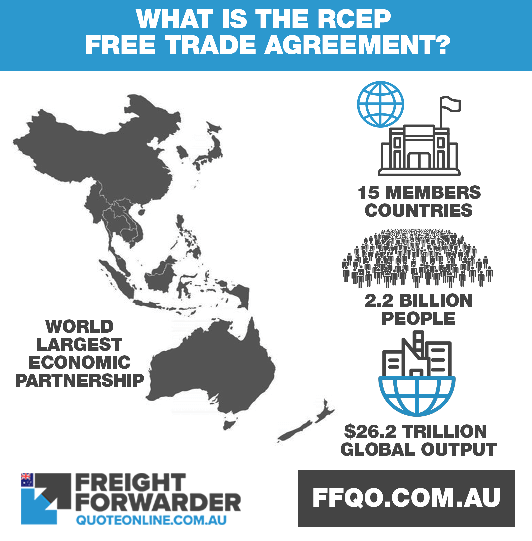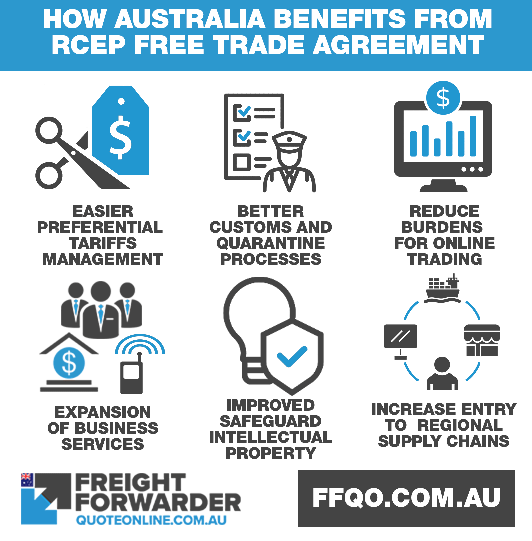Home » News »
RCEP free trade agreement and how Australia benefits the world’s largest economic partnership
« Previous | Next »
The Regional Comprehensive Economic Partnership (RCEP free trade agreement) is the largest economic partnership in the world. It commenced in January 2022 after more than 10 years in development. The RCEP free trade agreement will end tariffs on 91 per cent of goods to boost free trade and encourage investment with new common intellectual property regulations. Through the RCEP there will be a fusion of advantages and developments that will greatly benefit Australian agricultural and commercial operations.
 What is the RCEP free trade agreement (Regional Comprehensive Economic Partnership)?
What is the RCEP free trade agreement (Regional Comprehensive Economic Partnership)?
How does RCEP free trade agreement compares to others
The RCEP covers larger areas than more localised intergovernmental agreements. Such smaller agreements are the United States-Mexico-Canada Agreement (USMCA) and the European Union (EU).
The RCEP covers:
- 15 member countries
- 2.2 billion people
- $26.2 trillion global output
This consortium speaks for an industry association that covers almost one-third of all people in the world, and also the international market.
What countries are members of the RCEP agreement?
All up there are fifteen Asia-Pacific countries in the Regional Comprehensive Economic Partnership Agreement . The core members include the ten countries of the Association of South East Asian Nations (ASEAN). These countries are:
- Brunei, Indonesia and Malaysia
- Cambodia, Laos, Myanmar, Thailand and Vietnam
- Philippines and Singapore
The RCEP agreement also includes the ASEAN members’ five largest trading partners:
- Australia
- China
- Japan
- New Zealand
- South Korea
It is interesting that the agreement includes China but excludes the US and India.
How committed was Australia to make the RCEP agreement work?
Australia committed $46 million in technical assistance and capacity to help eligible ASEAN countries implement their RCEP commitments, ensuring RCEP delivers on its full potential. The agreement will drive greater investment certainty for businesses within the trade block.

RCEP is larger United States-Mexico-Canada Agreement (USMCA), Comprehensive and Progressive Agreement for Trans-Pacific (CPTPP) and the European Union (EU)
How RCEP will boost export opportunities for Australia?
Australian agriculturalists and enterprises will reap the benefits of greater international trade possibilities arising from the RCEP. Prime Minister Scott Morrison said ratification of this accord signified our region’s common resolve for a competitive market and strong financial sector notwithstanding the difficulties caused by the pandemic.
The Australian government has always had a focus supporting workers with job creation and retention, It supports promoting international trade within a strong free trade zone, and ensuring an even more robust supply and logistics network.
Scott Morrison, Prime Minister of Australia, recently said the RCEP, which expands on and further develops Australia’s market success, is a boon for Australian commerce. As 20 percent of all Australian jobs depend on commerce for their existence the RCEP will be pivotal for the post-pandemic recovery and rebuilding of Australia and its surrounding region.
Fastest growing economic region in the world
The RCEP extends across the world’s most rapidly developing economic area. The prospects for the countries covered by the RCEP will continue to enhance as their economies continue to improve and their populations further expand.
The RCEP represents the biggest free trade accord in the world. Simon Birmingham, Minister for Trade, said it will enhance Australia’s international trade prospects. Australia’s agronomists, commercial enterprises and financiers will enjoy new opportunities.
This agreement will further mesh Australian international traders with a profitable, highly successful world market in which RCEP members comprise close to 30 percent of the world’s GDP and population.
The agreement was pushed through by the ASEAN countries that constitute Australia’s joint trading partner and which have also drawn Australia, China, Japan, New Zealand and South Korea under the umbrella of this region-specific commercial bloc.
The RCEP free trade agreement has landed at just the right time relative to world commerce and trade precariousness. The level of commercial cooperativeness inherent in the agreement clearly telegraphs this region is as ardent a proponent of free trade for post-pandemic economic resurgence as in the pre-pandemic years .
Major benefits for Australia from the RECP free trade agreement
RCEP delivers greater transparency and reduces barriers to trade throughout South East Asia and South Pacific. The agreement also ensures commonality on guidelines and directive, thus simplifying operations throughout the region for Australian commercial operations and financiers. The RCEP free trade agreement will help drive Australia in expanding its export volume.
There are specific advantages available to Australian businesses in the commercial banking, schools, medical, scientific and technical and professional fields. This will apply once RCEP members have completed the assimilation of several sets of regulations to a common standard.
Australia is resolute in its commitment to ratify this agreement in the shortest possible time frame to ensure Australian agronomists, companies and financiers can begin to enjoy the advantages of RCEP. While RCEP will be inclusive, it will also welcome others, particularly India, to enter the agreement when and if they feel the time is right.
The major advantages for Australia and the RCEP consortium include:
- Set of common standards and processes for accessing preferential tariffs
New scopes for expansion in banking, telecommunications and professional services - Better methodologies for dealing with barriers to trade that do not involve tariffs such as customs and quarantine
- Single set of regulations for intellectual property and and e-commerce that will better safeguard IP and reduce burdens in online trading
- Mutually-accepted regulations on origin increasing the competitive capability of Australian entries into regional supply chains
A preferential tariff is where countries make an agreement to charge a lower rate to the WTO member tariff rate (most favoured nation tariff).
Experts have stated the fiscal advantages of RCEP are moderate and unlikely to be forthcoming in the short term. Nonetheless, the agreement was lauded as a diplomatic win for China just when the US’ commercial impact on Asia-Pacific was ebbing.

RCEP free trade agreement – how Australia benefits the world’s largest economic partnership
Need help working out how RCEP free trade agreement benefits you?
If you need help with your exports and want to maximise any benefits from the RCEP free trade agreement, feel free to contact us online or message via our Facebook page. We’re more than happy to help you export from Australia to South East Asia.
Check out our other recent articles
Latest news
Read up on the latest Australian freight forwarding news and developments:
Marine cargo insurance, should you buy it? - 28 May 2023
Aus UK FTA 2023 highlights in of the new free trade agreement - 07 Apr 2023
Types of cargo shipped via sea freight - 05 Mar 2023

Get social with us
Check us out on Facebook. Get social and like our page. Feel free to post your thoughts - we will appreciate it.
Come see our clips on our YouTube channel and subscribe so you are notified when we add new ones.
To keep up to date with the industry and read up on industry trends and developments, follow us on LinkedIn.
For quick updates, follow us on Twitter.
1300651233